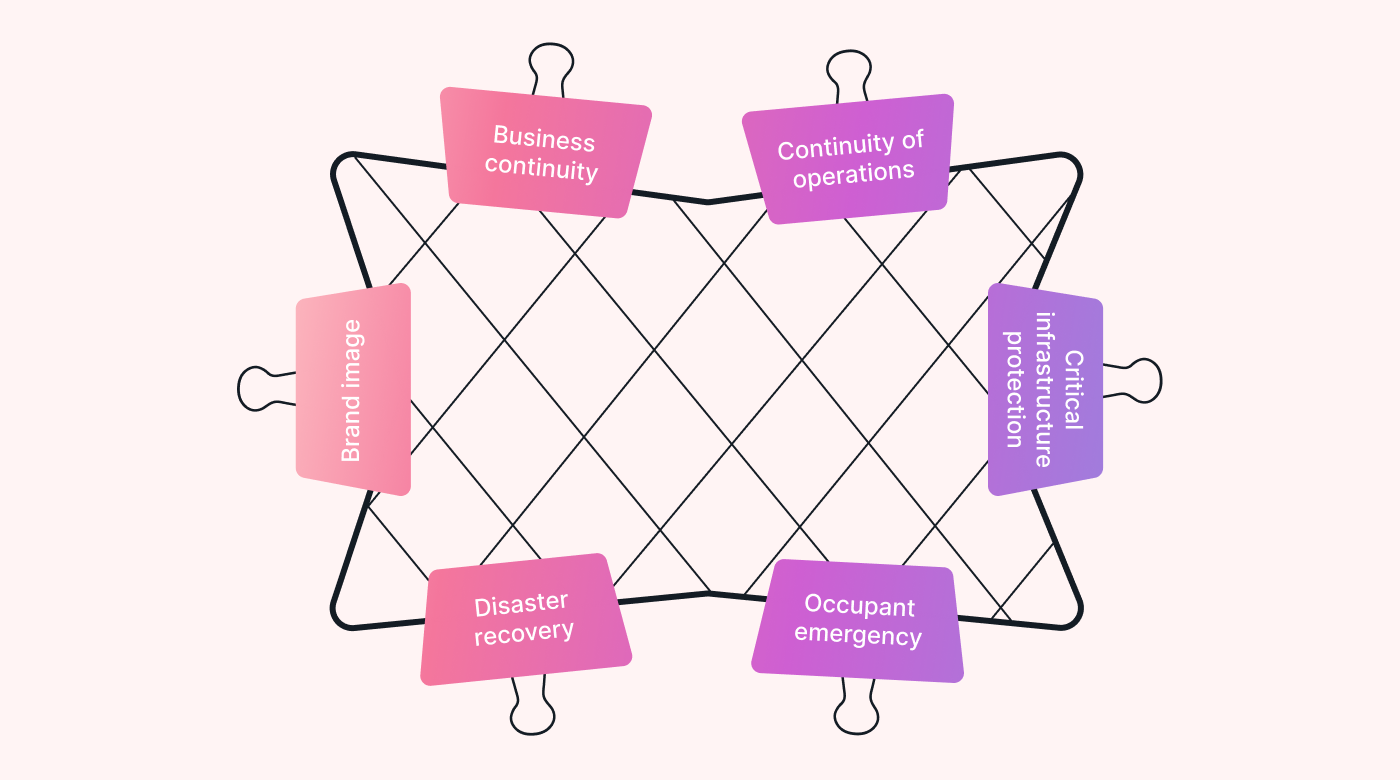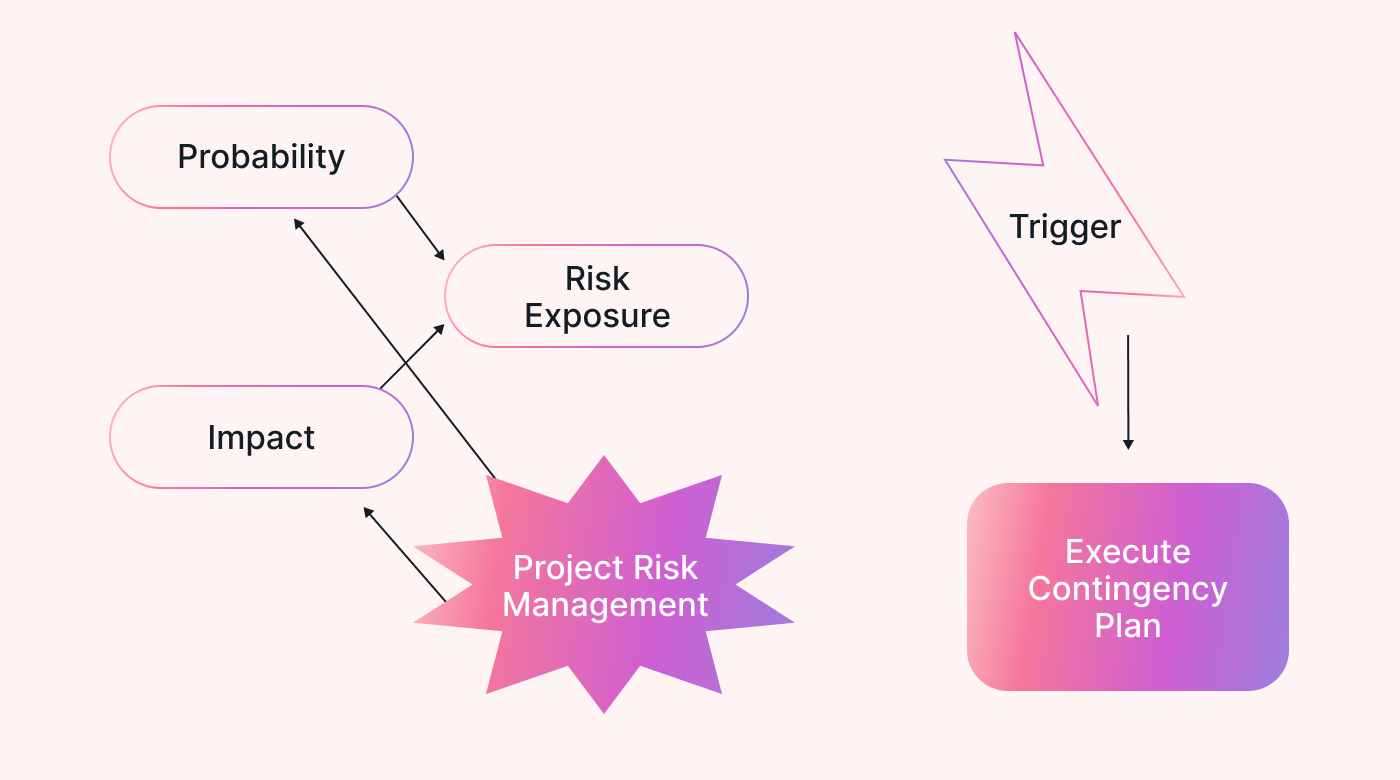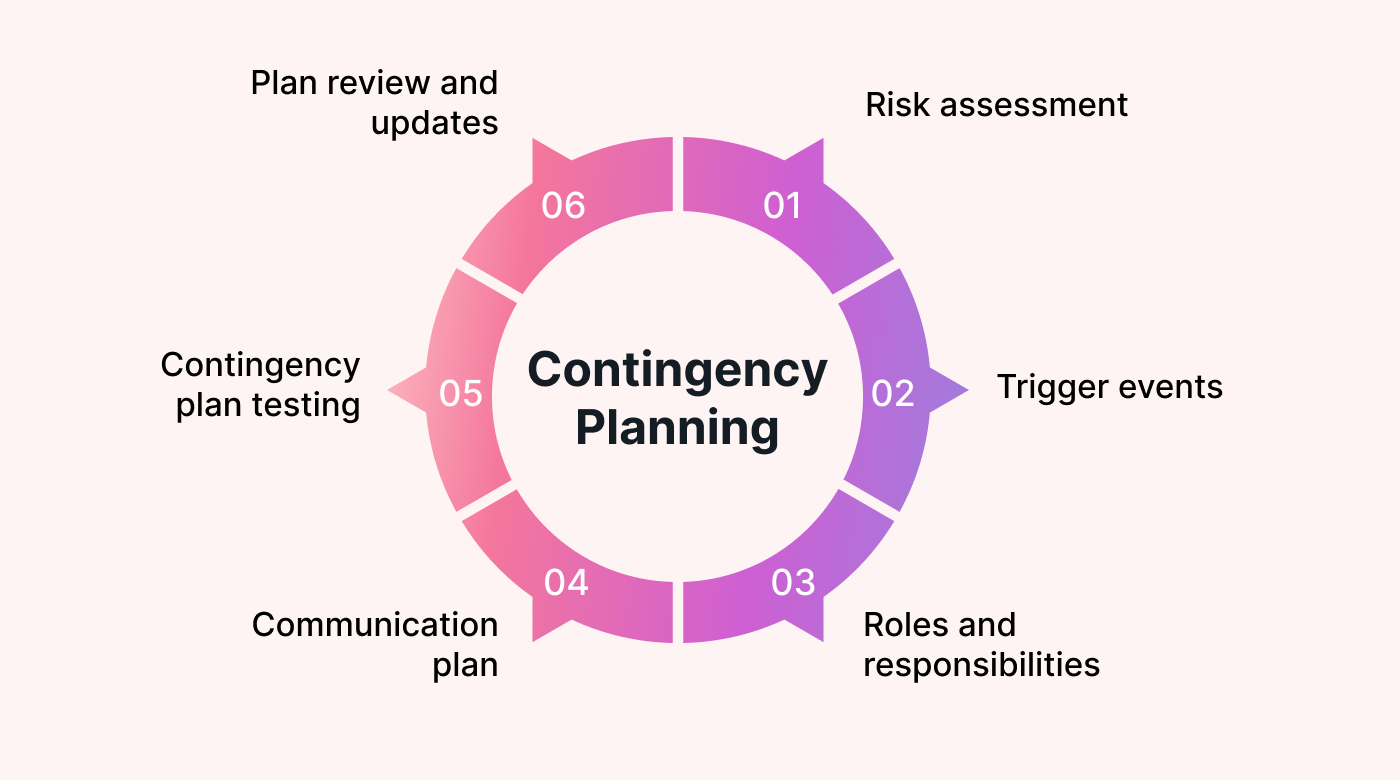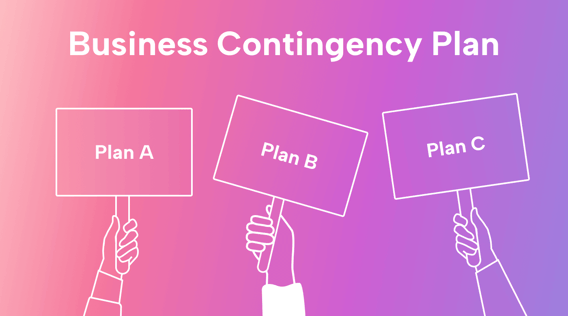The number of projects that fail to meet their milestones remains alarming. At least 67% of businesses that do not incorporate project management strategies into their plans fail.
Businesses may also fail for lacking a comprehensive contingency plan.
As a project manager, what would you do if you woke up one day to alerts of system breaches or natural calamities destroying your project? Don’t wait until that day to regret not having a plan B and C.
Luckily, contingency planning allows project managers to have a plan B and C that they can use when disasters happen. You can revise the contingency plan along the way, keeping it tailored to a business’ operating context.
In this article, we’ll cover:
- contingency planning, including its essential components,
- how it differs from project risk management,
- examples of contingency planning,
- and how to upgrade a contingency plan to ensure it remains relevant.
What is contingency planning?
A contingency plan entails a pre-formulated strategy should a project deviate from its intended path. In layperson’s terms, a contingency plan occurs when an already-identified risk occurs. Business contingency planning fosters preparedness against risks. These risks could lead to partial or complete project failure if not addressed timely.
 |
Some benefits of having a backup plan might include:
- Business continuity
- Critical infrastructure protection
- Disaster recovery
- Brand image
Not having a contingency plan weakens your response to unexpected events, which can increases your failure risk.
A real-world example of an organization that did not have a Plan B is the 2018 SamSam ransomware attack on the Atlanta, Georgia computer network. The attack forced the mayor to suspend most government services, including court proceedings. The City of Atlanta was yet to resume normal operations six days after the attack. It suffered huge losses before it could resume normal operations.
One study shows that 46.92% of agile projects fail because they did not have enough time and money. A contingency plan here might include alternate sources of funding or services available on credit.
Contingency planning vs. project risk management
Many people use the terms contingency planning and project risk management interchangeably. However, the terms have their differences (and apply to unique circumstances.) Let's first define what each term means before comparing them.
What contingency planning entails:
A good contingency plan explains what teams should do during disasters. It should provide a roadmap with event-specific actions to steer the project back to its intended pathway. There is no one-size-fits-all contingency plan. For example, a Plan B for natural disasters should address events like earthquakes.
What project risk management involves:
Project risk management involves monitoring a project to proactively identify risks that could lead to its failure. A goal of project risk management is to avoid failures before they occur or reduce how much they affect the project. Project managers should always be on the lookout for potential risks and act fast when they do occur.
 |
How contingency planning compares against project risk management.
Let's compare how contingency planning and project risk management apply. Though they both have distinct goals, they complement each other. In simpler terms, contingency planning covers risks that you can’t solve using the project risk management plan. It explains what the team should do after an unexpected event occurs.
For example, consider implementing a project in a foreign country. You should lookout for economic risks that could cause the project to fail. You can then take precautions. For example, a strategy might be using a more stable international currency vs the local currency. This strategy qualifies as project risk management.
In contrast, it may be impossible to predict when a natural disaster like an earthquake may occur. Thus, in regions that experience earthquakes, you should have back-up plans. The plans should explain what the team should do to reduce losses.
Components of a good contingency plan
There is no one-fits-all contingency plan. They differ depending on the type of business, environment, and context. For example, in areas affected by hurricanes, you should have a plan for the disaster. This may be unnecessary for areas away from water bodies.
It is clear that you cannot use one back-up plan for all emergencies. While this is true, most contingency plans share some similarities. Let's discuss some of them below:
Risk assessment:
Every contingency plan should start with a thorough risk assessment. You should identify factors that could threaten business survival.
Trigger events:
Trigger events are indicators that activate the contingency plan. You should identify the right time to use back-up plans. It should not be too early or too late.
Roles and responsibilities:
You should inform each team member of what they should do during disasters. You can use the RACI Matrix to delegate roles and responsibilities to team members. Make sure to communicate responsibilities, and address concerns to boost preparedness.
Communication plan:
Communication is one of the most important aspects of any contingency plan. Communicating with relevant stakeholders is essential when responding to an unexpected event. Thus, the action plan should include a contact list of essential responders. You should also reach out to direct stakeholders. Update your vendors, suppliers, and customers on the expected service disruption.
Contingency plan testing:
A common mistake many make is failing to test their contingency plans. Remember, a backup plan is only as good as its performance in real-life situations. Test a contingency plan by running tabletop exercises or drills. The plans should be practical and confirm team members’ preparedness.
Plan reviews and updates:
You should review and update contingency plans to match current situations. Updating a contingency plan also allows you to include new strategies.
 |
Examples of contingency plans
Below are two case scenarios of how unexpected disasters may play out depending on whether or not you have a contingency plan.
Scenario 1: Information system breach
With a contingency plan: Automated triggers start a system lockdown to prevent unauthorized access. Immediate red alerts to the cybersecurity team to identify and neutralize the source of the breach.
Without a contingency plan: It takes too long to detect the system breach. Loss of crucial information to malicious parties. Risk of future liability through class suits for failing to protect private information.
Scenario 2: Environmental disaster (earthquake)
With a contingency plan: Timely alerts to essential responders like firefighters and medical emergency teams. Occupant evacuation from the building is timely. Shift to offsite and remote resources to stabilize business operations.
Without a contingency plan: Total breakdown in operations and service delivery. Employees and clients remain stuck in the rubble for prolonged periods, increasing the risk of fatalities.
Evaluating the contingency plan
Testing the contingency plan
Contingency plan testing allows you to know the workability of a backup plan should disasters occur. The tests should be systematic and well-documented to support validation and repeatability. A good test plan should have a well-defined scope and assess specific protocols against test objectives.
You should test how Plans B and C would work in different environments. The plans should also consider the extent of the damages and the expected outcomes. For example, when testing a backup plan for an information system, check how long it takes to resume normal operations.
In our example of the 2018 SamSam ransomware attack, it’s unclear if the City of Atlanta did not have a Plan B or if they had an untested Plan B.
If the latter, their IT team would have known that the back-up plan is unreliable. They could have revised the plan to make it more effective during emergencies. A good Plan B would have saved the City and Mayor the bad reputation they got from the event.
Updating the contingency plan
The primary goal of a contingency plan is to respond to unexpected disasters. The term ‘unexpected’ means no one knows when the disaster will happen. The unpredictability of disasters makes updating your contingency plan even more important.
You can use the contingency plan test results to identify improvement areas. A common improvement area is adopting newer technology. You may also overhaul outdated infrastructure and organize training. Additionally, you should communicate contingency plan updates to all relevant team members. This includes changes in their roles and responsibilities..
In the past, some companies failed to update their back-up plans and paid for their mistakes.
For example, Delta Air Lines had a system outage in 2016, forcing them to cancel at least 2,000 scheduled flights. The company had a contingency plan for such attacks, but the plan was ineffective. Delta Air Lines lost at least $150 million in refunds and canceled flights. Incidents like this highlight why contingency plans must continuously be tested and updated.
Create your contingency plan today
More than likely, you have spent a lot of time and money to plan and roll out the project. You don’t want your project to fail at this point because you overlooked having a contingency plan.
Having a plan B and C for your project relieves you from unnecessary stress, allowing you to focus on achieving the intended goals. And you must update your contingency plan continuosly, ensuring it matches your business context.
Simplify your contingency planning tasks using Motion project management software. You can use the software to delegate tasks, schedule meetings, and disseminate information before, during, and after an expected event for speedy disaster recovery. Try Motion for free today!





